The Power of Dynamic Content: Personalizing the User Experience
What is Dynamic Content?
Dynamic content refers to website content that changes based on the behavior, preferences, and demographics of the user. It allows marketers to deliver personalized experiences to their audience, making the user journey more relevant and engaging.
Examples of Dynamic Content
There are various ways in which dynamic content can be implemented to enhance the user experience. Here are some examples:
1. Personalized Recommendations
Online retailers often use dynamic content to display personalized product recommendations based on the user’s browsing history or purchase behavior. This helps to increase conversion rates by showing users products that are relevant to their interests.
2. Location-Based Content
Websites can use dynamic content to display location-specific information such as weather updates, local events, or store locations. This helps to create a more personalized experience for users based on their geographical location.
3. Dynamic Forms
Forms can be dynamically customized based on the user’s previous interactions with the website. For example, a returning customer may see a shorter form with pre-filled information, while a new visitor may be prompted to provide more details.
Implementing Dynamic Content
Here are some tips for implementing dynamic content effectively:
1. Use Data to Inform Personalization
Collect data on user behavior, preferences, and demographics to inform your dynamic content strategy. This will help you deliver more relevant and personalized experiences to your audience.
2. Test and Optimize
Use A/B testing and analytics to measure the performance of your dynamic content and make adjustments as needed. Continuously optimize your content based on user feedback and engagement metrics.
3. Segment Your Audience
Segment your audience based on different criteria such as demographics, behavior, or purchase history. This will allow you to deliver targeted content that resonates with specific user groups.
The Benefits of Dynamic Content
There are several benefits to using dynamic content to personalize the user experience:
1. Increased Engagement
By delivering relevant content to users, you can increase engagement and keep visitors on your site for longer periods of time.
2. Higher Conversion Rates
Personalized recommendations and targeted messaging can lead to higher conversion rates and ultimately drive more sales for your business.
3. Improved Customer Satisfaction
When users feel that a website understands their needs and preferences, they are more likely to have a positive experience and return in the future.
Conclusion
Dynamic content is a powerful tool for personalizing the user experience and creating more engaging interactions with your audience. By implementing dynamic content strategies such as personalized recommendations, location-based content, and dynamic forms, you can enhance the user journey and drive better results for your business.
Remember to use data to inform your personalization efforts, test and optimize your content regularly, and segment your audience to deliver targeted messaging. By following these best practices, you can leverage the power of dynamic content to create a more personalized and engaging user experience.



![25 Best AI Social Media Tools to Try in 2024 [Tested Manually]](https://static.semrush.com/blog/uploads/media/d3/fa/d3fa26ef671a81b194bb3a41e73beee4/2c7e96d0d6ae1b7d2f993bdabf9b179b/25-best-ai-social-media-tools-to-try-in-2024.svg)

![The 10 Best AI Writing Tools to Try in 2024 [Tested Manually]](https://static.semrush.com/blog/uploads/media/3a/5e/3a5e0f6ec47a1d4e3495cf6c7a6194d5/8aee055881d17f9c5a0e1ed29dc749fb/the-10-best-ai-writing-tools-to-try-in-2024.svg)